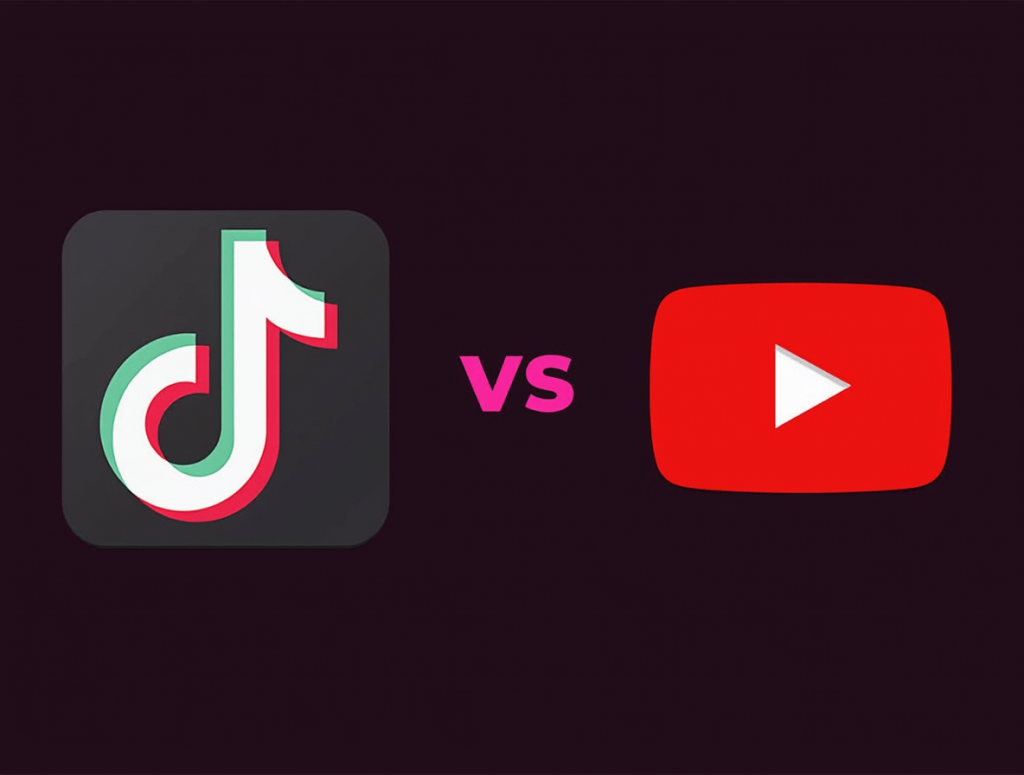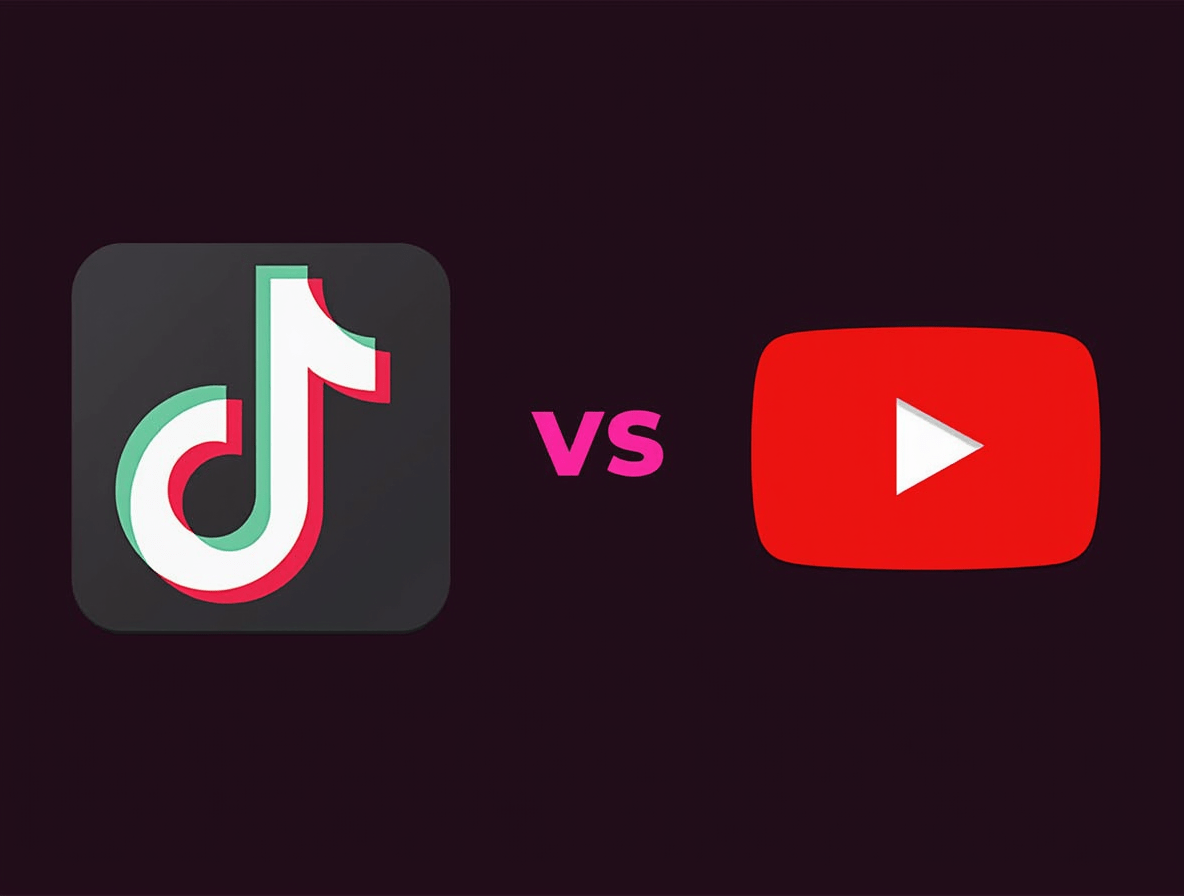
Short-form video has revolutionized digital content consumption, with users now watching over 2 billion hours of short videos daily across platforms. As attention spans shrink and mobile consumption rises, creators face a critical decision: should they invest their limited resources in TikTok, the pioneer that defined the format, or YouTube Shorts, the rapidly growing challenger backed by Google’s massive ecosystem?
This choice impacts everything from audience development and monetization potential to creative approach and long-term content strategy. With TikTok boasting 1.7 billion monthly active users and YouTube Shorts surpassing 2.5 billion monthly viewers, both platforms offer tremendous exposure—but in fundamentally different ways.
This comprehensive comparison examines how TikTok and YouTube Shorts differ across critical metrics including algorithm behavior, audience demographics, monetization options, and content performance to help you determine which platform better serves your specific short-form video goals.
Platform Fundamentals
TikTok: The Short-Form Pioneer
Launched globally in 2018, TikTok (known as Douyin in China) transformed video consumption with its immersive, full-screen vertical experience focused exclusively on short-form content. Key platform characteristics include:
- Video Format: Initially 15-60 seconds, now expanded to 10 minutes (though most viral content remains under 60 seconds)
- Core Experience: Endless scrolling through the algorithmically-driven “For You Page” (FYP)
- Discovery Mechanism: Primarily algorithm-based with minimal subscription reliance
- Content Focus: Entertainment-first, with trends, music integration, and effects central to the experience
- Creation Tools: Robust in-app filming, effects, sounds, and editing capabilities
- Platform Independence: Standalone app focused solely on short-form video
TikTok’s architecture prioritizes content over creators, with users discovering videos based on engagement patterns rather than subscription relationships. This creates both opportunity (instant exposure for unknown creators) and challenges (building sustainable audience connections).
YouTube Shorts: The Ecosystem Integrator
Launched in 2020 as YouTube’s answer to TikTok, Shorts is integrated within the broader YouTube ecosystem, which fundamentally shapes its approach to short-form video. Key platform characteristics include:
- Video Format: Up to 60 seconds, vertical orientation
- Core Experience: Dedicated Shorts feed within the YouTube app, plus integration with main YouTube experience
- Discovery Mechanism: Hybrid of algorithmic recommendation and channel subscription
- Content Focus: Broader content types, often extending or complementing long-form content
- Creation Tools: Basic filming and editing with sound extraction from YouTube’s library
- Platform Integration: Part of YouTube’s comprehensive video ecosystem
YouTube Shorts exists within the established creator ecosystem, connecting short-form content to channels, longer videos, and YouTube’s massive search functionality. This integration creates different growth dynamics compared to TikTok’s standalone approach.
Audience and Demographics
TikTok Audience Profile
TikTok has expanded far beyond its initial young user base, though it still skews younger:
- Age Distribution:
- 13-17: 25% of users
- 18-24: 32% of users
- 25-34: 22% of users
- 35-44: 13% of users
- 45+: 8% of users
- Gender Split: Approximately 57% female, 43% male globally
- Geographic Strength:
- Strongest in Southeast Asia and the United States
- Growing rapidly in Latin America and Europe
- Limited availability in some regions (notably India)
- Usage Patterns:
- Average daily time: 95 minutes
- Average sessions per day: 8
- Primary usage times: Evening and late night
TikTok users typically come for entertainment, trend participation, and discovery of new content rather than following specific creators. The platform excels at capturing fragmented attention throughout the day.
YouTube Shorts Audience Profile
YouTube Shorts inherits much of YouTube’s broad demographic reach while attracting new users:
- Age Distribution:
- 13-17: 18% of users
- 18-24: 29% of users
- 25-34: 26% of users
- 35-44: 16% of users
- 45+: 11% of users
- Gender Split: Approximately 54% male, 46% female globally
- Geographic Strength:
- Truly global presence through YouTube’s established infrastructure
- Strong in regions where TikTok is limited (India) or banned
- Particularly strong in North America, Europe, and India
- Usage Patterns:
- Often consumed alongside longer YouTube content
- Higher likelihood of topic-specific viewing sessions
- More search-driven discovery compared to TikTok
YouTube Shorts viewers often have existing channel relationships and use Shorts as part of a broader YouTube experience rather than a standalone activity.
Algorithm and Discovery Mechanics
TikTok’s Algorithm Approach
TikTok’s algorithm is arguably its defining feature, with several key characteristics:
Engagement-First Distribution
- Initial video test distribution to small audience sample
- Rapid scaling based on engagement signals
- Less emphasis on creator size or history
- Strong preference for native, platform-specific content
Key Performance Indicators
- Watch-through rate (most critical factor)
- Rewatch behavior
- Engagement actions (likes, comments, shares)
- Content completion rate
- Follower relationship (secondary factor)
Content Classification System
- Visual elements analysis
- Audio fingerprinting
- Hashtag and caption evaluation
- User interaction patterns
- Contextual relationships between content pieces
TikTok’s algorithm provides unparalleled opportunity for rapid growth, with unknown creators regularly reaching millions of views. However, this also creates volatility, with view counts fluctuating dramatically between videos.
YouTube Shorts’ Algorithm Approach
YouTube Shorts employs a modified version of YouTube’s recommendation engine:
Hybrid Distribution Model
- Algorithmic recommendation to non-subscribers
- Priority distribution to existing channel subscribers
- Integration with YouTube search functionality
- Cross-promotion with standard videos
Key Performance Indicators
- Watch time and retention
- Engagement rate based on impressions
- Channel subscription conversion
- Cross-content viewing behavior
- Historical creator performance
Ecosystem Integration Factors
- Relationship to creator’s long-form content
- Viewer history across YouTube ecosystem
- Search relevance and keyword alignment
- Topic and niche authority signals
- Channel subscription status
YouTube Shorts typically provides more stable, predictable growth that builds upon existing channel presence rather than TikTok’s viral but sometimes unpredictable distribution.
Content Strategy Differences
Effective TikTok Content Strategies
TikTok rewards specific content approaches:
Platform-Native Content
- Created specifically for TikTok, using in-app features
- Participation in current trends and challenges
- Utilization of popular sounds and effects
- Vertical formatting with key elements centered
Hook-Driven Structure
- Immediate attention grabbing in first 1-2 seconds
- Curiosity gaps and pattern interruptions
- Question-based openings with promised answers
- Visually striking or surprising first frames
Engagement Optimization
- Content that encourages rewatching
- Open loops that keep viewers watching to resolution
- Call-to-actions for comments and interaction
- Trend participation with unique variations
Content Types That Excel
- Entertainment and humor
- Quick educational insights (“TikTok taught me”)
- Day-in-the-life and authentic moments
- Surprising reveals and transformations
- Dance and music-based content
TikTok success typically requires higher posting frequency (often daily) with content specifically designed for the platform rather than repurposed from elsewhere.
Effective YouTube Shorts Strategies
YouTube Shorts favors somewhat different approaches:
Ecosystem Integration
- Content that complements long-form videos
- Hooks that drive viewers to full videos
- Topic consistency with channel theme
- Bridge content between major uploads
Search-Optimized Approach
- Keyword-relevant titles and descriptions
- Topic-focused content with clear substance
- Informational value beyond pure entertainment
- Niche-specific content matching channel focus
Channel Growth Focus
- Strong branding and creator personality
- Consistent posting schedule
- Calls-to-action for channel subscription
- Series-based content with continuity
Content Types That Excel
- Highlights or teasers from longer videos
- Tutorial snippets and how-to content
- Product reviews and demonstrations
- Behind-the-scenes glimpses
- Commentary and reaction content
YouTube Shorts generally rewards content that serves as an entry point to a creator’s broader content ecosystem rather than standalone entertainment.
Creator Growth Potential
TikTok Growth Trajectory
TikTok offers a distinct growth pattern:
Fast Initial Exposure
- Potential for rapid viral moments from zero following
- Algorithm willingness to test unknown creators
- Less dependency on existing audience
- Higher ceiling for single-video performance
Follower Acquisition Challenges
- Lower subscription rates despite high views
- Weaker creator-audience relationship formation
- Higher content discovery through FYP than profile visits
- Need for consistent trend participation to maintain visibility
Typical Growth Patterns
- Explosive but inconsistent view counts
- Often requires 6-12 months of consistent posting for stable growth
- Highly dependent on regular posting frequency
- Greater algorithm volatility and performance swings
TikTok can create overnight sensations but often struggles with sustainable audience development compared to subscriber-focused platforms.
YouTube Shorts Growth Trajectory
YouTube Shorts facilitates different growth dynamics:
Integrated Audience Building
- Leverages existing YouTube subscriber base
- Shorts viewers more likely to subscribe to channels
- Cross-pollination between short and long-form content
- More stable, gradual audience growth
Search-Driven Discoverability
- Evergreen potential through search functionality
- Topic and keyword relevance for long-term discovery
- Less dependent on recency and algorithmic favor
- Content remains discoverable for longer periods
Typical Growth Patterns
- More consistent view counts between videos
- Often shows compounding growth over time
- Benefits creators already making long-form content
- Lower initial viral potential but higher long-term stability
YouTube Shorts generally builds more durable audience relationships but may offer less explosive initial growth compared to TikTok.
Monetization Comparison
TikTok Monetization Options
TikTok offers several revenue streams for creators:
TikTok Creator Fund
- Payment based on video performance
- Typically $0.02-0.04 per 1,000 views
- Requires 10,000 followers and 100,000 views in 30 days
- Often criticized for low payout rates
- Being replaced with new Creativity Program in some regions
TikTok Creativity Program Beta
- Improved revenue share for eligible creators
- Focus on videos longer than one minute
- Higher payouts than original Creator Fund
- Currently invitation-based with 100,000 follower minimum
LIVE Gifts and Tips
- Virtual gifts converted to diamonds and then cash
- Available to creators with 1,000+ followers
- Platform takes approximately 50% commission
- Highly dependent on active, engaged audience
Brand Partnerships
- Creator Marketplace for brand connections
- Branded content opportunities
- Often higher-paying than platform monetization
- Requires business appeal and professional approach
TikTok Shop Integration
- In-video product tagging
- Affiliate commissions on sales
- Live shopping capabilities
- Available in limited markets currently
TikTok monetization generally requires large view volumes to generate significant revenue, with most creators earning more through off-platform opportunities than native monetization tools.
YouTube Shorts Monetization Options
YouTube provides a more developed monetization ecosystem:
Shorts Revenue Sharing
- Part of YouTube Partner Program
- Revenue from ads displayed between Shorts
- Typically higher than TikTok’s per-view payout
- Requires 1,000 subscribers and 4,000 watch hours (or 10M Shorts views)
- Pool-based revenue sharing model
Channel Membership Integration
- Monthly subscriber fees for exclusive benefits
- Shorts viewers can convert to paying members
- Creates recurring revenue streams
- Requires 1,000+ subscribers and eligibility review
Super Thanks
- Viewer appreciation payments on Shorts
- Direct fan-to-creator monetary support
- Available to eligible YouTube Partners
- Higher retention of payment compared to TikTok gifts
Long-Form Video Conversion
- Shorts as funnel to monetized long-form content
- Higher CPM rates on standard YouTube videos
- More developed ad ecosystem overall
- Multiple ad formats and placement options
YouTube Premium Revenue Share
- Portion of Premium subscription fees based on watch time
- Applies to Shorts views from Premium members
- Passive income potential from library content
- Generally higher-value than standard ad revenue
YouTube typically offers more substantial and diverse monetization potential, particularly for creators who use Shorts as part of a broader content strategy rather than as a standalone format.
Production and Creative Tools
TikTok Creation Tools
TikTok provides comprehensive in-app creation capabilities:
Filming Features
- Multiple speed options (0.3x-3x)
- Countdown timer for solo filming
- Frame-precise editing tools
- Various camera filters and effects
- Green screen and background features
Sound and Music
- Extensive licensed music library
- Sound mixing and voice effects
- Voiceover recording and adjustment
- Original sound creation and sharing
- Auto-captioning capabilities
Editing Capabilities
- In-app text with multiple animation styles
- Effect timing and adjustment
- Stickers and visual enhancements
- Automated tools like photo animation
- Templates for common video formats
TikTok’s creation tools are designed for mobile-first creation without requiring external software, making the barrier to content creation extremely low.
YouTube Shorts Creation Tools
YouTube Shorts offers a more streamlined creation experience:
Filming Features
- 15 or 60-second recording options
- Speed controls (0.3x-3x)
- Timer and countdown functionality
- Basic filters and color correction
- Green screen effects
Sound and Music
- YouTube’s licensed music library
- Sound sampling from any YouTube video
- Basic voice recording capabilities
- More limited sound editing options
- Auto-caption functionality
Editing Capabilities
- Text addition with basic styling
- Simplified multi-segment editing
- Fewer built-in effects and transitions
- Integration with YouTube Studio for analytics
- Thumbnail customization options
YouTube Shorts’ creation tools are more limited than TikTok’s, with many creators preferring to produce content in external apps before uploading to the platform.
Platform Limitations and Challenges
TikTok Limitations
TikTok presents several challenges for creators:
Algorithm Volatility
- Unpredictable view fluctuations
- Difficulty maintaining consistent exposure
- Trend dependence for visibility
- Rapid content cycles requiring constant creation
Platform Uncertainty
- Ongoing regulatory challenges in multiple countries
- Potential bans or restrictions in key markets
- Data security and privacy concerns
- Shifting company ownership and direction
Audience Retention
- Lower subscription-to-view ratio
- Weaker creator loyalty compared to YouTube
- More difficult to direct audience to external platforms
- Higher competition for attention within the app
Monetization Barriers
- Generally lower direct revenue potential
- Higher barriers to monetization eligibility
- Less transparent payment structures
- Limited shopping features in many regions
TikTok’s strengths in discovery and viral growth are counterbalanced by challenges in sustainable audience building and monetization.
YouTube Shorts Limitations
YouTube Shorts has its own set of constraints:
Algorithm Segmentation
- Potential cannibalization of long-form content
- Unclear impact of Shorts performance on main channel
- Separate recommendation systems creating audience silos
- Mixed signals on platform priorities
Creative Constraints
- More limited native creation tools
- Less robust effects and editing capabilities
- Fewer trending sounds and music options
- Less developed collaborative features
Discovery Challenges
- Lower pure viral potential than TikTok
- More dependent on existing channel performance
- Less effective for new creator discovery
- More competitive space as adoption increases
Content Strategy Conflicts
- Tension between short and long-form strategies
- Audience expectations for content style consistency
- Channel focus dilution concerns
- Unclear optimal balance between formats
YouTube Shorts offers more stability but potentially lower viral ceiling and more complex integration considerations with existing content strategies.
Platform Data and Analytics
TikTok Analytics Capabilities
TikTok provides creators with various performance metrics:
Content Performance Data
- Video views and average watch time
- Traffic source breakdown
- Audience territories and demographics
- Follower growth attribution
- Peak viewing times
Engagement Metrics
- Like, comment, and share rates
- Completion rate and rewatch value
- Sound and hashtag performance
- Profile visits from videos
- Follow conversion rate
Analytics Limitations
- Limited historical data (typically 28-60 days)
- Basic audience insight capabilities
- Fewer comparative analysis tools
- Limited export functionality
- Less detailed than YouTube analytics
TikTok’s analytics focus primarily on content performance rather than audience understanding or strategic planning.
YouTube Shorts Analytics
YouTube offers more comprehensive analytics integration:
Content Performance Data
- Views, watch time, and retention curves
- Traffic source analysis
- Audience demographics and geography
- Time-based performance trends
- Device and platform breakdown
Ecosystem Integration Metrics
- Shorts to long-form conversion
- Subscription attribution
- Channel growth impact analysis
- Revenue contribution data
- Cross-content audience flow
Advanced Features
- A/B testing capabilities for thumbnails
- Detailed audience insights
- Historical data comparison
- Advanced export options
- Integration with Google ecosystem
YouTube provides significantly more robust analytics with longer historical windows and greater strategic planning utility.
Cross-Platform Strategy Considerations
Many creators choose to use both platforms with strategic content adaptations:
Platform-Specific Optimization
Content Adaptation Approaches
- Creating platform-native versions of similar content
- Adjusting pacing and structure for each platform
- Platform-specific calls-to-action and engagement hooks
- Visual formatting optimized for each environment
Cross-Promotion Strategies
- Using TikTok for discovery and YouTube for deeper engagement
- Teasing exclusive content on complementary platform
- Building initial audience on TikTok, monetizing on YouTube
- Testing content concepts on one platform before investing in longer formats
Workflow Efficiency
- Batched filming sessions for both platforms
- Primary and derivative content approaches
- Shared planning but platform-specific execution
- Tools and services for cross-platform management
Multi-Platform Success Stories
Creators like Charli D’Amelio, MrBeast, and cooking influencer Nick DiGiovanni have successfully leveraged both platforms by:
- Building initial audiences on TikTok with viral content
- Developing deeper engagement through YouTube’s longer formats
- Creating cross-platform content ecosystems with platform-optimized versions
- Using each platform’s strengths complementarily rather than competitively
Making Your Platform Choice
When TikTok May Be Better
TikTok typically offers advantages for creators who:
- Are starting from zero and need initial audience discovery
- Create primarily entertainment and trend-based content
- Excel at concise, attention-grabbing formats
- Prefer in-app creation with minimal external editing
- Prioritize maximum view counts over subscriber growth
- Target primarily Gen Z and younger Millennial audiences
- Create visually dynamic, music-driven content
- Want to build an influencer presence quickly
When YouTube Shorts May Be Better
YouTube Shorts generally works better for creators who:
- Already have an established YouTube presence
- Create educational, informational, or specialized niche content
- Want to build a sustainable subscriber base
- Prefer external production with higher production quality
- Are focused on long-term monetization potential
- Target a broader age demographic
- Use short-form as entry to longer content
- Value content longevity and search discoverability
Conclusion
Both TikTok and YouTube Shorts offer tremendous opportunities for short-form video creators, but they serve fundamentally different strategies and objectives.
TikTok excels as a standalone short-form platform with unmatched viral potential, trend participation, and initial audience discovery. Its algorithm-driven approach can catapult unknown creators to massive viewership overnight, but this comes with challenges in sustainable growth, monetization, and platform stability.
YouTube Shorts leverages the power of YouTube’s established ecosystem, offering more stable growth, better monetization, and stronger audience relationships. While it may not match TikTok’s viral ceiling, it provides better integration with broader content strategies and more predictable career development for creators.
The “better” platform ultimately depends on your specific goals, content style, target audience, and growth strategy. Many successful creators use both platforms strategically, adapting content to each environment while building a comprehensive cross-platform presence.
The most important factor is platform-native excellence—understanding and embracing the unique attributes of whichever platform you choose rather than applying a one-size-fits-all approach to short-form video.
FAQ Section
Do I need to create different content for each platform?
While you can repurpose content across platforms, performance typically improves with platform-specific optimization. TikTok favors native creation using in-app tools, trending sounds, and platform-specific features. YouTube Shorts performs better with content that aligns with your channel theme and can serve as an entry point to longer videos. At minimum, consider adjusting captions, calls-to-action, and pacing for each platform.
Which platform pays creators better?
YouTube generally offers better direct monetization potential through its more developed Partner Program, with Shorts revenue sharing typically outperforming TikTok’s Creator Fund on a per-view basis. However, top TikTok creators often earn substantial income through brand deals, the Creativity Program, and live gifts. For most creators, YouTube provides more accessible and consistent monetization, while TikTok may offer higher brand partnership potential for creators who achieve viral status.
How does video length affect performance on each platform?
On TikTok, despite the 10-minute maximum, shorter videos (15-30 seconds) still typically perform best for discovery, with the algorithm favoring high completion rates. For established TikTok creators, 1-3 minute videos can work well under the Creativity Program. On YouTube Shorts, videos under 30 seconds often struggle with retention metrics, while 45-60 second videos provide better watch time statistics and recommendation potential. Each platform’s optimal length continues to evolve as user behavior changes.
Can I grow on both platforms simultaneously, or should I focus on one?
Resource limitations make it challenging for most creators to excel on both platforms simultaneously when starting out. For creators with limited time, focusing on one platform initially allows for better understanding of platform-specific best practices and more consistent posting. Once workflows are established, expanding to the second platform becomes more manageable. Many successful creators start on TikTok for initial audience building, then expand to YouTube for deeper engagement and better monetization.
Which platform offers better longevity for content?
YouTube Shorts typically offers significantly longer content lifespan due to its search functionality and recommendation system that continues to surface relevant content regardless of age. TikTok’s algorithm heavily favors recency, with most content receiving the majority of views within the first 48 hours after posting. For evergreen, reference, or educational content, YouTube Shorts generally provides better long-term value and discovery potential.














